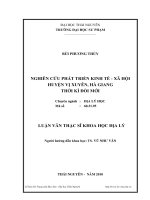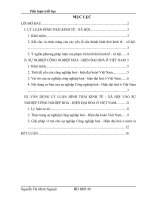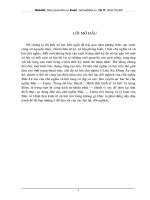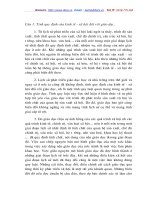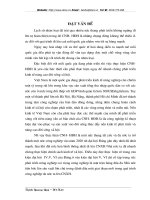NGHIÊN CỨU GÁNH NẶNG KINH TẾ XÃ HỘI ĐỐI VỚI PHƠI NHIỄM THUỐC LÁ CHỦ YẾU VỀ BỆNH TIM MẠCH Ở VÙNG NÔNG THÔN_TÂY NAM TRUNG QUỐC
Bạn đang xem bản rút gọn của tài liệu. Xem và tải ngay bản đầy đủ của tài liệu tại đây (293.35 KB, 28 trang )
The economic burden of tobacco
exposure-related major cardiovascular
diseases in rural south- west China
Cai Le, MD, Ph.D.
Professor
School of Public Health
Kunming Medical University
Outline
Background
Objective
Methodology
Results
Conclusions
Background
Cardiovascular
diseases (CVD) are a major
public health concern in the world, accounting
for half of all non-communicable disease
deaths worldwide. China is also experiencing
an epidemic of CVD during recent decades.
Smoking was an independent risk factor for
CVD, and secondhand smoke (SHS) is also d
emonstrated to be an established cause of C
VD in previous studies.
Background
As
one of the most costly diseases, CVD
represents a major economic burden on
healthcare systems. However, the literature
on the economic consequences of CVD
associated with tobacco use is still sparse in
China.
Objectives
The
aim of this study is to use a prevalencebased, disease-specific cost-of-illness
method to estimate the economic burden of
two major components of CVD (coronary
heart disease and stroke) attributable to both
smoking and exposure to SHS in rural
southwest China including direct and indirect
costs.
Methodology
Study area and population
This study was a community-based, cross-sectional
survey conducted in four rural areas of Yunnan
province, China.
Yunnan is located in southwest China and had a
recorded population of 45.9 million people.
Yunnan is a production and consumption hub for
tobacco products, tobacco is cultivated in 45 of the
province’s counties and more than 2.3 million
farmers in the province are engaged in tobacco
cultivation.
Cost components
The
cost of CVD comprised two components:
direct costs and indirect costs. Direct costs
were further divided into two subcategories:
direct medical costs and direct non-medical
costs.
Data source
Information
regarding the prevalence,
economic consequences and related aspects
of CHD and stroke, smoking habits, and
exposure to SHS in rural areas of Yunnan
province were obtained from a communitybased cross-sectional health interview and
examination survey.
Sampling technique
A
multi-stage stratified random sampling
method was used to select individuals aged
≥18 years from a total of 44 townships in
Yunnan province.
Multi-stage stratified random sampling
129 Counties in Yunnan Province
Tobacco cultivation areas
Economically
advantaged
Economically
disadvantaged
Non-tobacco cultivation areas
Economically
advantaged
Economically
disadvantaged
All townships (44 townships)
PPS sampling
Village 1
Village 2
SRS sampling
Individuals
Village 3
……
Data collection
Each participant who gave the informed consent was
personally interviewed face-to-face by trained
interviewers, using a pre-tested structured questionnaire.
Information on demographic characteristics, self-reported
smoking habits, annual disease specific inpatients
hospitalization expenditures, expenditures for outpatient
visit and self-medication, direct non-medical costs, and
work absence due to target disease were obtained
through the questionnaire.
Definitions
CHD
and stroke was identified by selfreported physician diagnosis.
Smokers were defined as persons who had
smoked at least 100 cigarettes in their
lifetime.
Exposure to SHS was defined as nonsmokers who reported exposure to
environmental tobacco smoke at home or at
work for a minimum of 15 minutes at least
one day per week.
Calculation of Population Attributable
Fraction (PAF)
P (OR 1)
PAF
100%
P (OR 1) 1
Where: P denotes to the prevalence of
smoking or exposure to SHS in a given
population, and OR denotes odds ratio for
disease-specific morbidity caused by
smoking or exposure to SHS.
Calculation of direct costs
The
costs associated with outpatient/inpatient
visits were estimated by multiplying the
number of outpatient visits/inpatient hospital
admissions related to CVD by the
outpatient/inpatient unit costs per year.
Calculation of indirect costs
Indirect
costs were estimated as the earnings
lost as a result of CVD-related morbidity
using the “human capital” approach.
Statistical analysis
Descriptive
analysis techniques and
multivariate logistic regression were used in
this study. All data analyses were conducted
with R2.9.2 software
Results
Demographic characteristics of
the study population
A total of 18,000 individuals
aged ≥18 years were asked
to participate in this study.
Of these, 17,158 agreed to
participate (response rate =
95.3%).
Participants in the study
included 8,156 males and
9,002 females.
Prevalence of smoking, SHS ,
and CVD
The
overall prevalence of smoking and
exposure to SHS in the study population was
35.5% and 42.2, respectively.
The overall prevalence of stroke and CHD
was 1.0% and 1.7% among the surveyed
population, respectively.
OR and PAF% of major cardiovascular
diseases associated with smoking and SHS
Secondhand smoke exposure
(SHS)
Smoking
Variables
Multivariable
adjusted OR †
(95% CI)
PAF(%)
Multivariable
adjusted OR †
(95% CI)
PAF(%)
Male
2.42** (1.28, 4.58)
50.93
2.32** (1.26, 4.25)
33.98
Female
4.01* (1.38, 11.68)
3.77
1.92** (1.18, 3.11)
28.39
All
2.46** (1.67, 3.64)
34.14
2.04** (1.39, 2.97)
30.50
Male
8.32** (3.88, 17.87)
84.25
3.54** (2.14, 5.87)
49.76
Female
4.27** (1.85, 9.84)
4.08
1.60** (1.14, 2.23)
20.55
All
5.34** (3.15, 9.03)
60.64
1.94** (1.45, 2.59)
28.40
Stroke
CHD
OR and PAF% of major cardiovascular
diseases associated with smoking and SHS
There
were significant positive associations
between smoking, exposure to SHS and risk
for stroke and CVD for both sexes.
Cost of illness of major cardiovascular
diseases (in US$) in rural southwest China
Stroke
Coronary heart disease
Unit cost
Total
(million)
Unit cost
Male
Female
All
Total
(million
)
Direct medical
costs
1238.0
1565.0
1406.8
8.71
2324.6
1331.7
1738.0
16.16
Outpatient visits
13.70
35.6
26.2
0.16
42.3
30.62
34.5
0.32
Hospitalization
1048.3
1292.0
1171.9
7.26
1928.4
1052.5
1415.2
13.16
Self-medication
176.04
237.42
208.7
1.29
353.8
248.6
288.3
2.68
Direct non-medical
costs
19.43
102.21
60.03
0.37
31.9
59.3
48.6
0.45
Total direct costs
1257.4
1667.2
1466.8
9.08
2356.5
1391.1
1786.6
16.61
9.82
23.12
19.3
0.12
14.5
39.1
31.2
0.29
1267.2
1690.4
1486.2
9.2
2371.0
1430.2
1817.9
16.9
Cost components
Total indirect costs
Total cost of
illness
Male
Femal
e
All
Cost of illness of major cardiovascular
diseases (in US$) in rural southwest China
Males had higher unit costs of illness due to
CHD than females, whereas unit costs of
illness due to stroke were higher in females
than in males (P<0.05).
Inpatient hospitalizations represented the
main component of direct costs of CVD, and
direct costs were the main drivers of the
economic burden of CVD.
Cost of CVD attributable to smoking
and exposure to SHS
Variables
Costs of illness attributable to
smoking
(million)
Costs of illness attributable to
secondhand smoke exposure
(million)
Direct
costs
Indirect
costs
Total cost of
illness
Direct
costs
Indirect
costs
Total cost of
illness
Male
3.97
0.31
4.28
2.65
0.21
2.86
Female
0.37
0.05
0.42
2.77
0.38
3.15
All
4.34
0.36
4.70
5.42
0.59
6.01
Male
15.55
0.01
15.56
10.9
0.07
10.97
Female
0.03
0.002
0.03
3.18
0.09
3.27
All
15.58
0.01
15.59
14.08
0.16
14.24
Stroke
CHD
